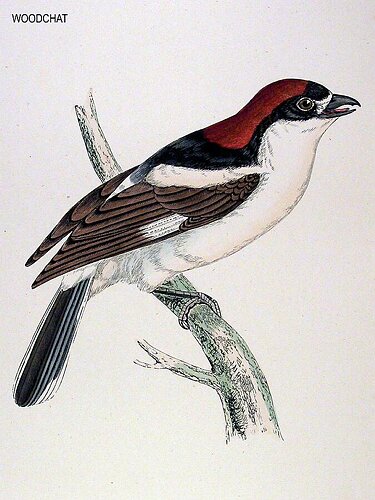WOODCHAT.
Y CIGYDD GLASS, IN ANCIENT BRITISH. WOOD SHRIKE. WOODCHAT SHRIKE.
Lanius rufus, BRISSON. BEWICK. Lanius rutilus, LATHAM. MONTAGU. Lanius
pomeranus, GMELIN.
Lanius—A butcher. Rufus—Red.
This Shrike is found in Europe—in Germany, France,
Denmark, the Netherlands, Switzerland, Sicily, Italy, Greece, and
Russia. In Africa—in Egypt, Senegal, Gambia, the Gold Coast,
and at the Cape of Good Hope. In Asia, in Turkey, Palestine, Persia,
and Arabia.
The following are the only specimens of the Woodchat that appear to
have been recorded as having occurred in England—In Yorkshire,
one; in Kent, two, one of them near Canterbury; in Sussex, near Brighton;
in Devonshire, at Plymouth; in Hampshire, where it has been known
to breed twice in the Isle of Wight, at Freshwater, and a young bird
was shot in September, 1856; others in Hertfordshire, and Nottinghamshire.
In Norfolk, two, one of them near Swaffham; in Suffolk, four or five;
in Worcestershire, one, near Evesham; in Cornwall, two, in the Scilly
Islands, one an adult male, the other an immature bird, in September,
1849; others since also; one in Derbyshire, May 19th., 1839; and one
near Guildford, in Surrey; also in Lancashire, Cumberland, and Northumberland.
In Ireland and Scotland none have been met with, unless indeed the
account of one recorded to have occurred in Forfarshire, is correct.
The Woodchat is by no means of a shy nature, but builds in the immediate
vicinage of houses and public roads. It exhibits an antipathy against
other birds, even those which it cannot prey on, such as magpies and
pigeons, chasing and driving them from its haunts.
The most extraordinary fact connected with this bird, as with others
of its species, is its mode of dealing with its food—already
described:
one has been seen fixing a yellow-hammer on a thorn. It feeds occasionally
on such small birds, but also on worms, caterpillars, and insects:
it takes its prey on the ground, as well as in the air. I have in
a previous article given my opinion as to its having been fancied
that the Shrikes' motive in fixing their prey in the curious way they
do, was to act decoy. 'Credat, non ego.'
The note is not much more than a chirp.
The nest is said to be placed in the angle of the branches of a tree
—a preference being given to the oak. It is composed of sticks,
wool, and moss, and lined with wool and fine grass.
The eggs are described by Mr. Hoy as being four or five in number
and varying much in marking as well as in size. In some the ground
colour is pale blue; in others dull white, with a band of rust-coloured
spots round the lower end; in others the whole surface is more or
less spotted with a lighter colour. Mr. Hewitson describes one from
the fine collection of the Messrs. Tuke, of York, in which the spots,
which are large and deep in colour, of a brown or neutral tint, are
scattered equally over the whole surface. Others again are white tinged
with green or pale olive, blotted with different darker shades, olive
and lilac, the markings in some more diffused, and again as spots,
forming a belt or band. Both birds sit on the eggs in turns.
Male; length, seven inches and a half; bill, black, (Meyer says bluish
horn-colour at the tip, and dull yellowish red at the base,) notched
near the tip, and depressed at the point: the feathers around its
base are whitish. Iris, dark brown, (Meyer says pale chesnut,) the
eye is surrounded by black, ending in a small patch; on the cheek
is a narrow streak of white. Forehead, brownish black; head, bright
olive brown; crown and nape, rich chesnut red; with a large patch
of white above the wing coverts; chin, throat, and breast, white,
or yellowish white; back, dusky black above, ending below in grey.
Greater and lesser wing coverts, brownish black, the former faintly
edged with white; primaries, dusky black, white at the base, forming
a spot when the wing is closed: the first feather is less than half
as long as the second; the third, fourth, and fifth longer than the
second; or according to Selby, the second longer than the fifth, but
this may be another instance of the uncertainty of the relative length
of the quill feathers in some cases, so as that no absolute rule should
be laid down; the third the longest in the wing; secondaries, dusky
black, white at the ends. The tail, which is graduated, has the middle
feathers brownish black, with indistinct bars, the outer one on each
side white, excepting one or more dark bars on the inner web; the
next, white on the inner half, black on the end half, white at the
tip; the next, with a white tip only. Upper tail coverts, white, sometimes
tinged with yellowish; under tail coverts, the same. Legs and toes,
black; claws, black, (Meyer says slate-coloured,) sharp, grooved,
and curved.
Female; length, eight inches; bill, dark brown; head, rufous; but
more dull than in the male; neck, rufous; nape, dull rufous; a large
patch of white above the wing coverts, but not so clear as in the
male. Chin and throat, dull white; breast, dull white, tinged with
red, particularly on the sides, where the feathers are tipped with
brown, forming bars more or less in some individuals; back, rufous
brown, fading into grey below. The wings expand to the width of one
foot one inch; greater and lesser wing coverts, edged with rufous;
primaries, dark brown, without any transverse lines; secondaries,
dark brown; tertiaries, dark brown, edged with yellowish white; tail,
brown; legs and toes, dark brown.
The young bird is distinguished by transverse brown lines on the back,
and grey ones on the breast.
This species appears to vary much.
"The birds, great Nature's happy Commoners
That haunt in woods and meads, and flowery gardens."
ROWE.
